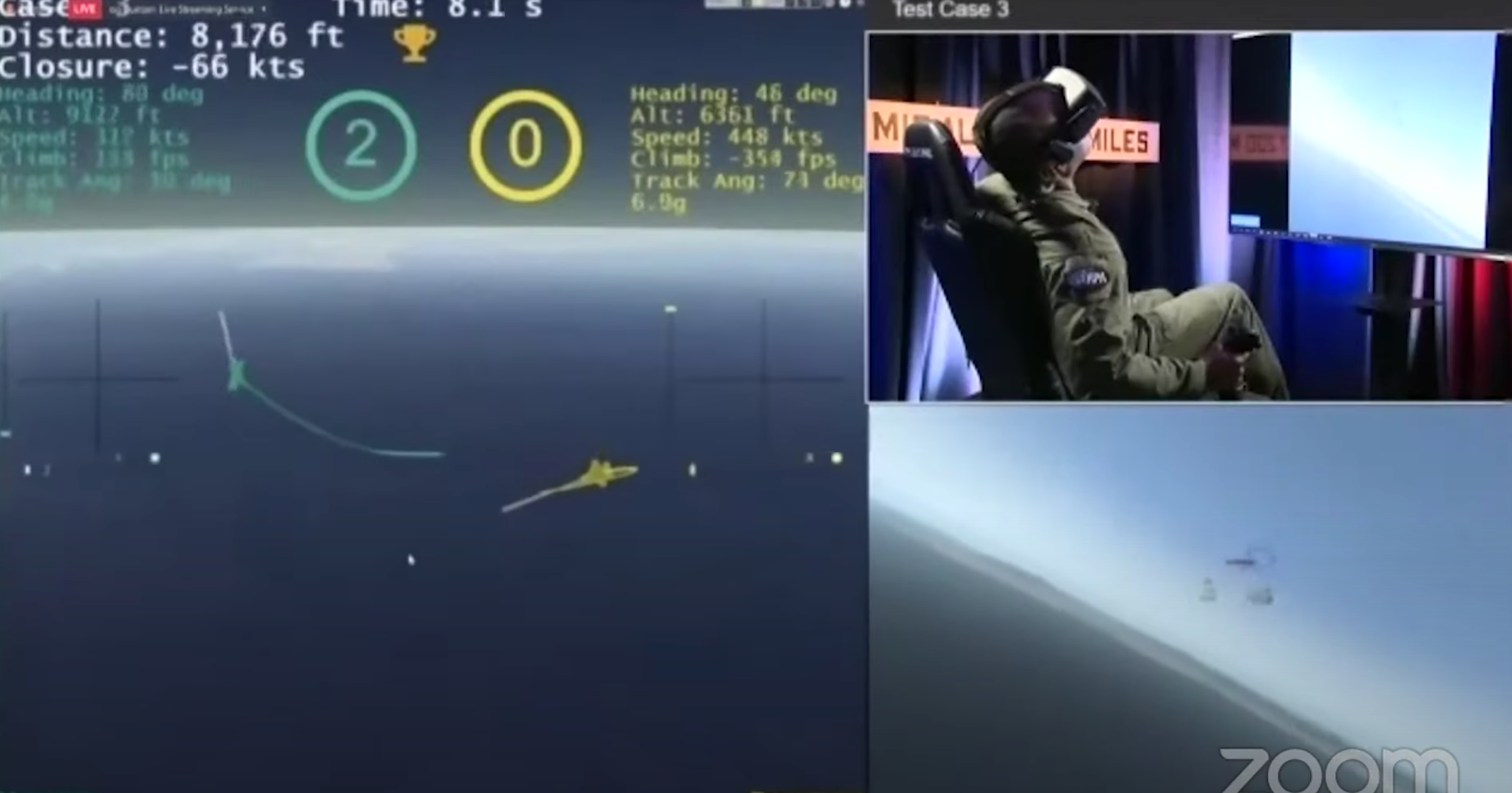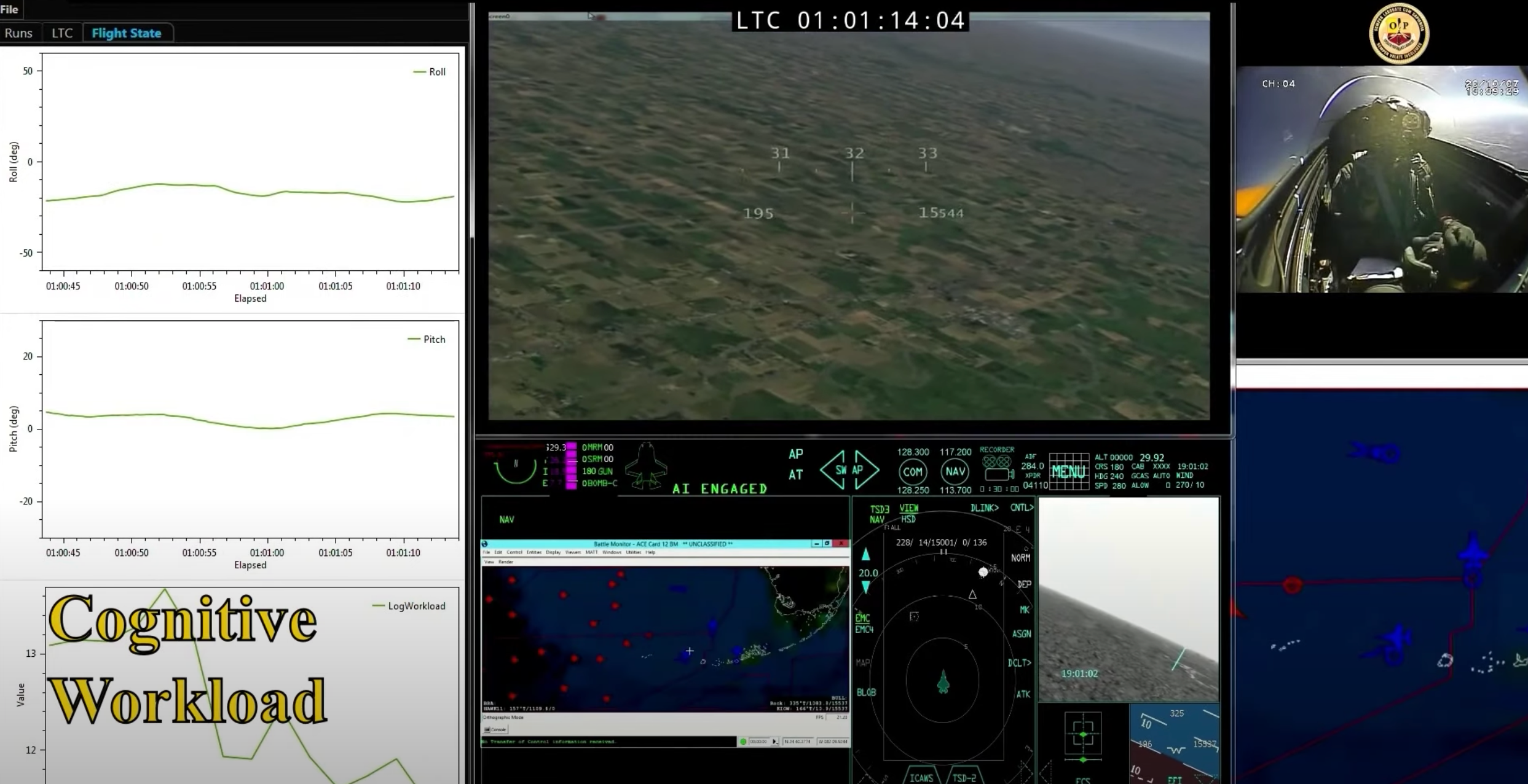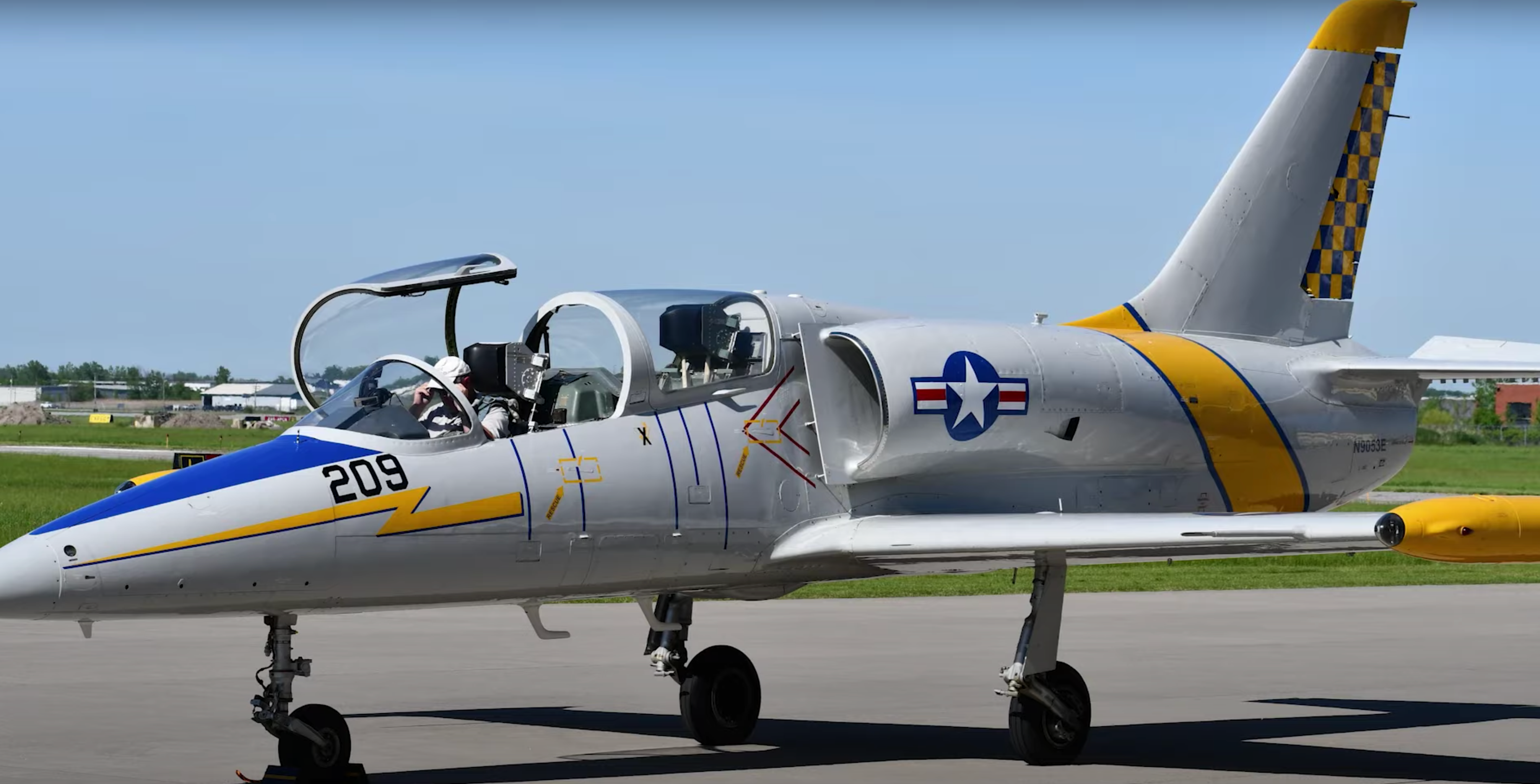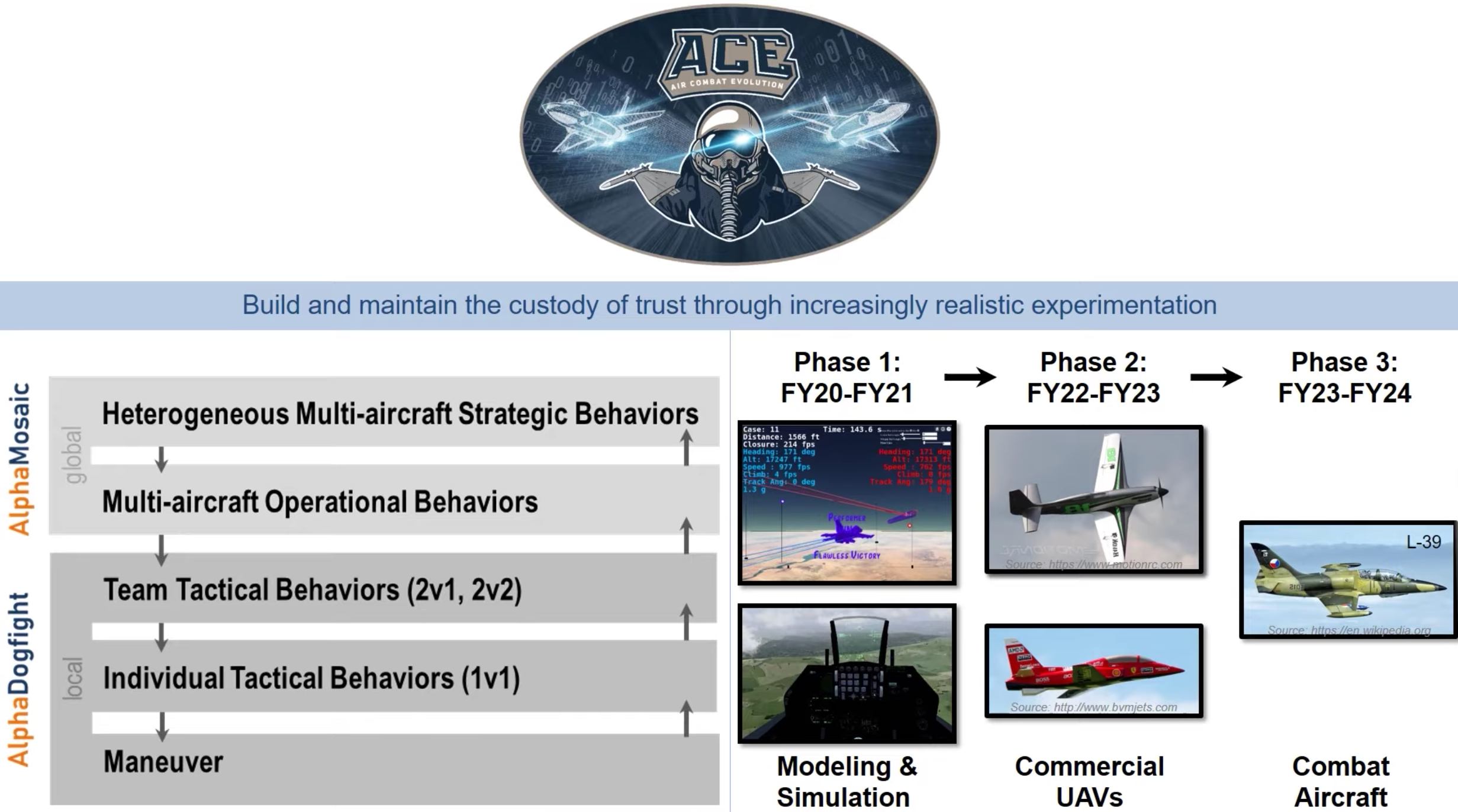BY THOMAS NEWDICK

The goal of bringing artificial intelligence into the air-to-air dogfighting arena has moved a step closer with a series of simulated tests that pitted AI-controlled F-16 fighter jets working as a team against an opponent. The experiments were part of Phase 1 of the Defense Advanced Research Projects Agency’s (DARPA) Air Combat Evolution (ACE) program, focused on exploring how AI and machine learning may help automate various aspects of air-to-air combat.
DARPA announced recently that it’s halfway through Phase 1 of ACE and that simulated AI dogfights under the so-called Scrimmage 1 took place at Johns Hopkins Applied Physics Laboratory (APL) last month.
Using a simulation environment designed by APL, Scrimmage 1 involved a demonstration of 2-v-1 simulated engagements with two blue force (friendly) F-16s working collaboratively to defeat an undisclosed enemy red air (enemy) aircraft.
In the words of DARPA, the ambitious ACE program aims to develop “trusted, scalable, human-level, AI-driven autonomy for air combat by using human-machine collaborative dogfighting as its challenge problem.”
The February AI dogfight tests were the first since APL’s AlphaDogfight Trials that took place last August. On that occasion, a competition pitted eight teams who provided AI systems to fly simulated F-16s in 1-v-1 dogfights. The team with the winning AI then flew another five simulated dogfights against an experienced F-16 fighter pilot in a simulator, beating the human 5-0 in a significant demonstration of AI’s potential that you can read more about here.
“Our biggest focus at the end of Phase 1 is on the simulation-to-real transition of the AI algorithms as we prepare for live-fly sub-scale aircraft scenarios in late 2021,” said Colonel Dan “Animal” Javorsek, the program manager in DARPA’s Strategic Technology Office. “Managing this transition to the real world is a critical test for most AI algorithms. In fact, prior efforts have been brittle to just these types of transitions because some solutions can be over-reliant on digital artifacts from the simulation environment.”
Compared to the AlphaDogfight Trials, which were gun-only, Scrimmage 1 introduced new simulated weapons, in the form of a “missile for longer-range targets.”
“Adding more weapon options and multiple aircraft introduces a lot of the dynamics that we were unable to push and explore in the AlphaDogfight Trials,” Javorsek added. “These new engagements represent an important step in building trust in the algorithms since they allow us to assess how the AI agents handle clear avenues of fire restrictions set up to prevent fratricide. This is exceedingly important when operating with offensive weapons in a dynamic and confusing environment that includes a manned fighter and also affords the opportunity to increase the complexity and teaming associated with maneuvering two aircraft in relation to an adversary.”

YOUTUBE SCREENCAP
A pilot takes on an AI opponent during the AlphaDogfight Trials.
So far, ACE has demonstrated advanced virtual AI dogfights involving both within-visual-range (WVR) and beyond-visual-range (BVR) multi-aircraft scenarios with simulated weapons, plus live flying using an instrumented jet to measure pilot physiology and trust in AI.
Throughout the ACE program, which began last year, DARPA has stressed the importance of establishing human pilots’ trust in AI, allowing it to conduct the actual combat maneuvers while the human concentrates on overarching battle management decisions.
The process of “capturing trust data” has seen test pilots fly in an L-29 Delfin jet trainer at the University of Iowa Technology Institute’s Operator Performance Laboratory. This aircraft has been adapted with cockpit sensors to measure the pilot’s physiological responses, giving an insight into whether or not the pilot trusts the AI. In these missions, the L-29 has been flown by a safety pilot in the front seat, who makes flight control inputs based on AI decisions. However, for the pilot whose responses are being evaluated, it is as if the AI is flying the jet.

YOUTUBE SCREENCAP
Test pilots in an L-29 Delfin jet trainer assess the pilot’s physiological responses to AI-generated flight commands.
ACE Phase 2, planned for later this year, will add dogfights involving live subscale aircraft, both propeller-driven and jet-powered, to ensure that the AI algorithms can be moved out of the virtual environment and into real-world flying. Meanwhile, Calspan has also begun work on modifying a full-scale L-39 Albatros jet trainer to host an onboard AI “pilot” for Phase 3, a set of live-fly dogfights scheduled for late 2023 and 2024.

YOUTUBE SCREENCAP
The L-39 Albatros will serve as the mount for an onboard AI “pilot” under Phase 3 of ACE.
Once this concept is proven, DARPA plans to insert the AI technology developed in loyal wingman-type drones, like Skyborg, working collaboratively alongside manned fighters. In this way, the drones would be able to conduct dogfights with some autonomy, while the human pilot in the manned aircraft focuses primarily on battle management.
Ultimately, this AI could be crucial in realizing the dream of a fully-autonomous unmanned combat air vehicle (UCAV) capable of air-to-air combat, as well as air-to-ground strikes, something The War Zone has explored in great depth in the past. While a UCAV would be able to perform many of the same functions as manned aircraft, its AI “brain” would be able to make key decisions faster and more accurately, taking into account much more information in a shorter period of time, without any concern about being distracted or confused by the general chaos of combat. The same algorithms could also be adapted to enable drones to be networked into swarms that work cooperatively to maximize their combat effectiveness, with decisions being made far quicker than a human-piloted formation.

YOUTUBE SCREENCAP
A slide from a DARPA presentation showing the planned phases within ACE.
The same AI technology, however, also has applications as a “virtual co-pilot,” the kind of concept that’s being developed under R2-D2, a program run by the Air Force Research Laboratory’s (AFRL) Autonomy Capability Team 3 (ACT3). In this way, software and other systems that emerge from ACE could potentially provide new kinds of automated assistance to the crew of manned aircraft.
Clearly, ACE has the potential to feed into a variety of different Air Force programs in the realm of autonomous and semi-autonomous unmanned aircraft capabilities, as well as providing another layer of rapid decision-making for manned types. While the ability of AI algorithms to win out in virtual dogfights has now been proven, later this year we should get the chance to see how this technology translates into live flying, too.
No comments:
Post a Comment